“We want it to be an icon for modern India.”1
Architect Sanjay Singh, Director of Arcop Associates Pvt. Ltd., replied when asked about the message he wishes to convey as the architect of the newly built Bharat Mandapam-the International Exhibition-cum-Convention Centre (IECC).

Image © https://www.medianews18.com/
While it remains to be seen whether the building will be considered an iconic piece of architecture, just like its predecessor; the Hall of Nations and Industries by Raj Rewal and Mahendra Raj, it raises a critical question – What makes any building “iconic”?
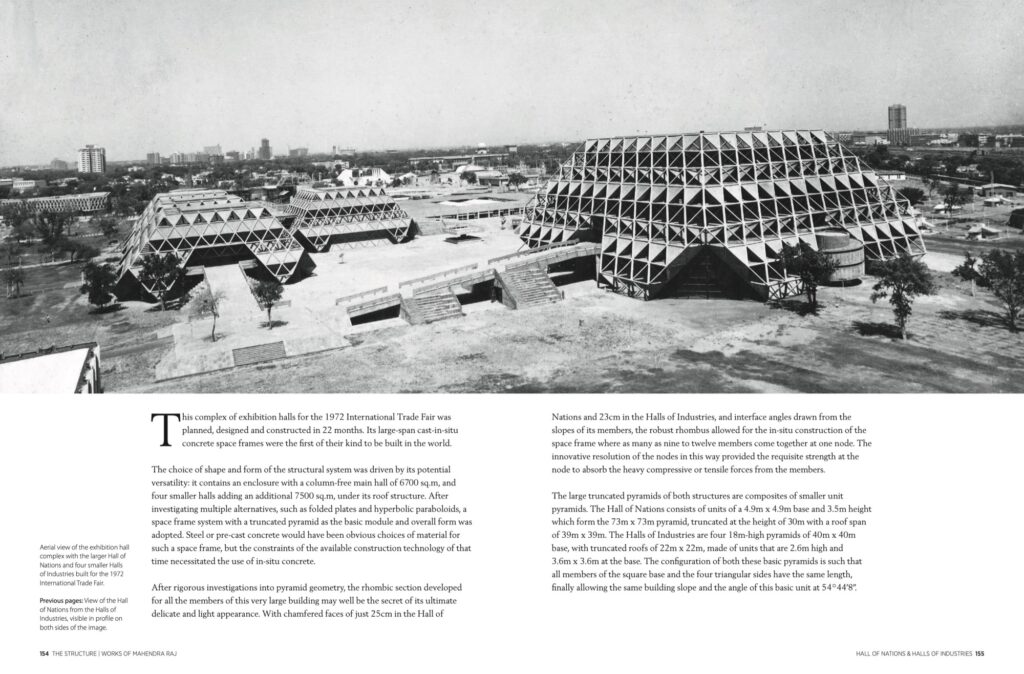
“Iconic” after all has become ubiquitous yet misunderstood by our episteme.2 For Patrik Schumacher, the idea of iconic architecture is “a product of the critics’ discourse that plays no role in the architects’ discourse” as the term helps to fill the gap about the innovative design that cannot be fully explained to the non-architectural community.3 For Simone Brott, iconic architecture is a building that presents a brave and uncanny resemblance to the conceived structure in the design phase- the building’s identical twin, as they call it.4 Without any fixed parameters to give it a global definition, everyone has ambivalent views about what can be considered iconic. Yet, the architecture community does not shy away from calling the demolished Hall of Nations and Industries an “icon”.
One of the key factors that made the Hall of Nations iconic was its distinctive and revolutionary design. Rewal’s vision for the building was groundbreaking and innovative, challenging traditional architectural norms. The building’s structural system, by Mahendra Raj, with its interconnected large-span cast-in-situ concrete space frames, was a marvel of engineering and a symbol of India’s modernization.
“…what emerged to be the most iconic example of this tendency toward structural expressionism in the architecture of the 1970s were the permanent exhibition halls designed in 1972 by Raj Rewal, in collaboration with Mahendra Raj, for Pragati Maidan.” 5
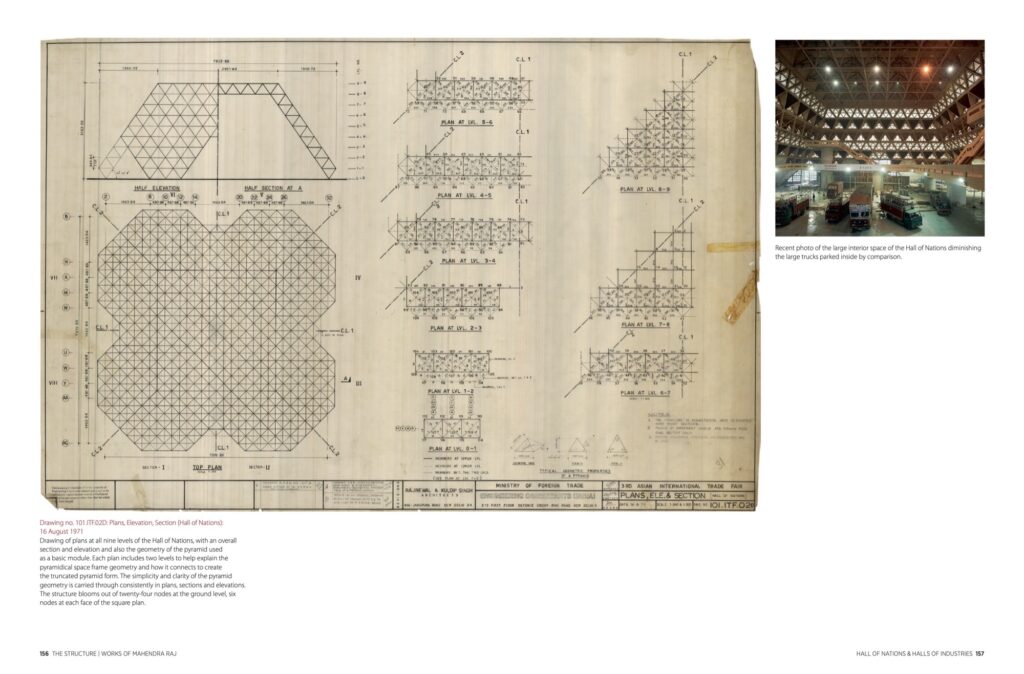
Furthermore, the Hall of Nations had a profound impact on the architectural world as it represented the spirit of post-independence India. Constructed in 1972 to commemorate the 25th anniversary of India’s independence, it embodied the nation’s aspirations for progress and development. The building was an architectural statement that celebrated India’s cultural heritage while embracing modernity and creating a sense of unity among the people.
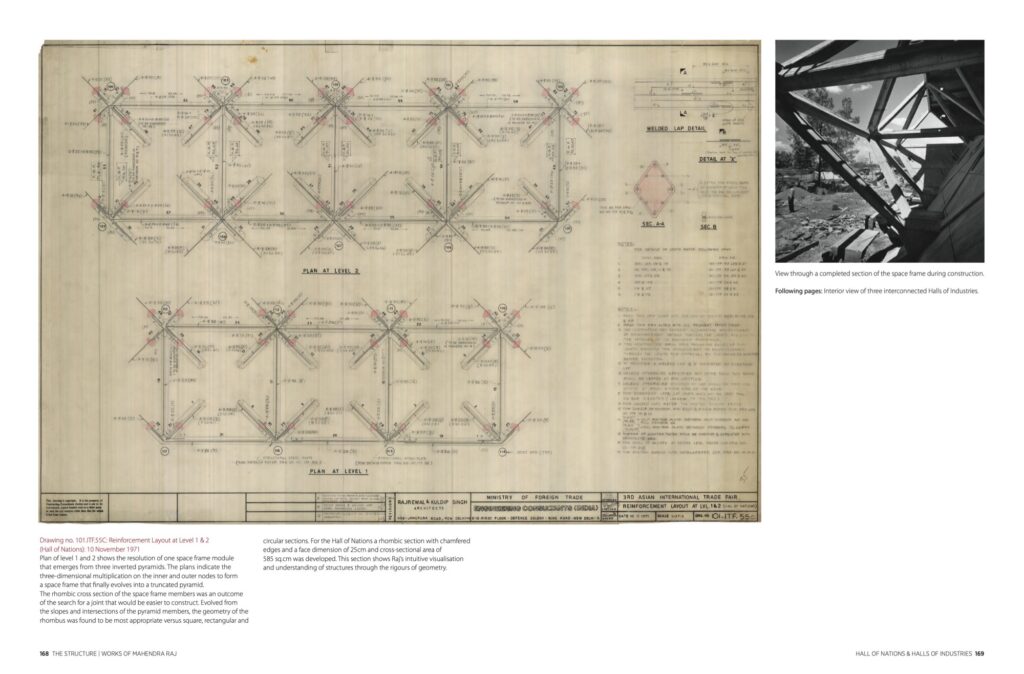
Amit Srivastava’s and Peter Scriver’s description of the modernists including Raj Rewal and Mahendra Raj in their book about the modern architecture of India rings true when we place their respective work styles to view the genesis of the Hall of Nations and Industries. Designed and constructed in 22 months for the 1972 International Trade Fair, it was a design that evolved to meet the constraints of not just time, but also the availability of materials and labour.

The unavailability of steel and the available construction technology at that time led to the use of in-situ reinforced concrete that was “harder to design” explained Mahendra Raj.7 After extensive research on alternatives, a basic module of a space frame system with a truncated pyramid was adopted for the structure.
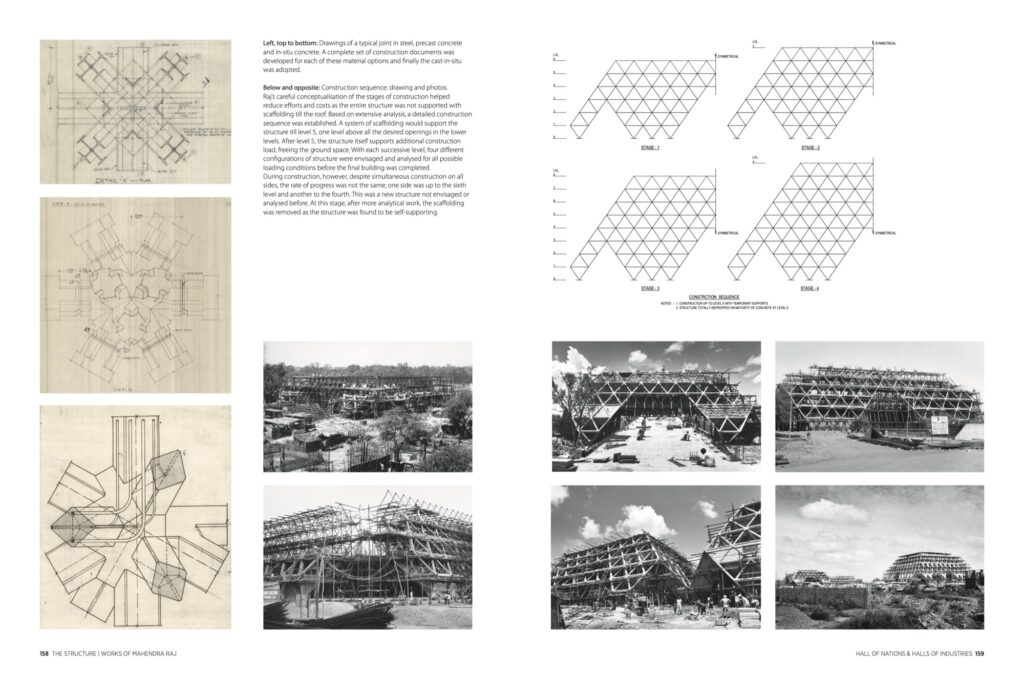
The Hall of Nations and Industries with its chamfered faces and interface angles that followed the slope of its members, allowed for the construction of a space frame on-site, with up to twelve members connecting at one node. Referred to as an innovative design in The Structure – Works of Mahendra Raj, these nodes possessed the necessary strength to withstand the heavy compressive or tensile forces from the members.
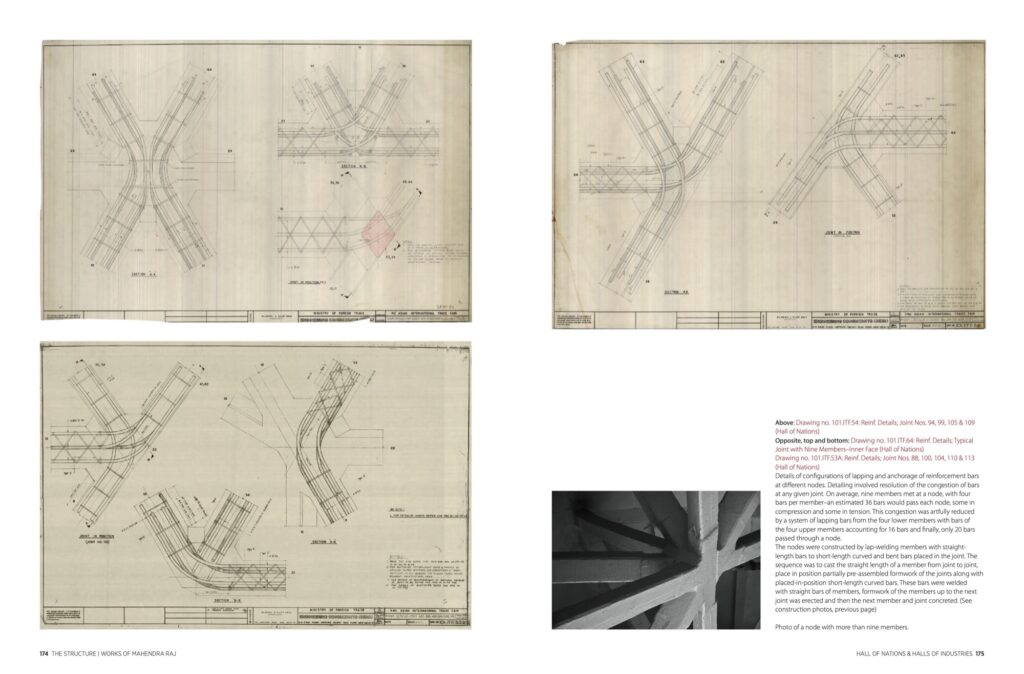
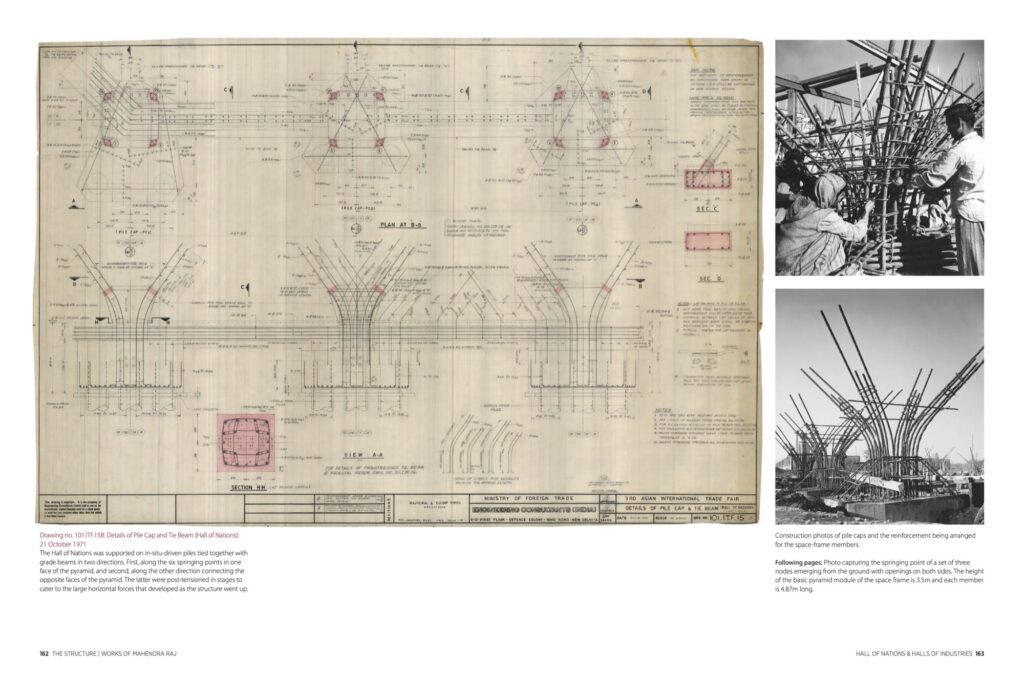
The building consisted of units of a 4.9m x 4.9m base and 3.5m height that formed the 73m x 73m pyramid, truncated at the height of 30m with a roof span of 39m x 39m. Surrounded by Halls of Industries, these were four 18m-high pyramids of 40m x 40m base, with truncated roofs of 22m x 22m, made of units that are 2.6m high and 3.6m x 3.6m at the base.8 With such immense clear heights, these exhibition halls had ample space for showcasing various items- from books to bulldozers.
The depth of the structural system was utilised as a sun breaker, conceived like a traditional jali– a geometrical pattern of perforation that obstructs direct rays of the harsh sun while permitting air circulation.
Ample evidence exists in the public domain to impress on the structure being an icon for technological development in the context of the nationalism of the 1970s. “It brokered a compromise between the old Nehruvian idealism of universal modernist ambition, and the weight of a socio-economic reality in which an abundance of labour, however poor in technical skills and resources, had to be redressed”.9 It was a bold expression in its presence while fuelling the necessary sparks for what modern architectural heritage [can and should] means for conservation in India, it continues to remain one in its absence.
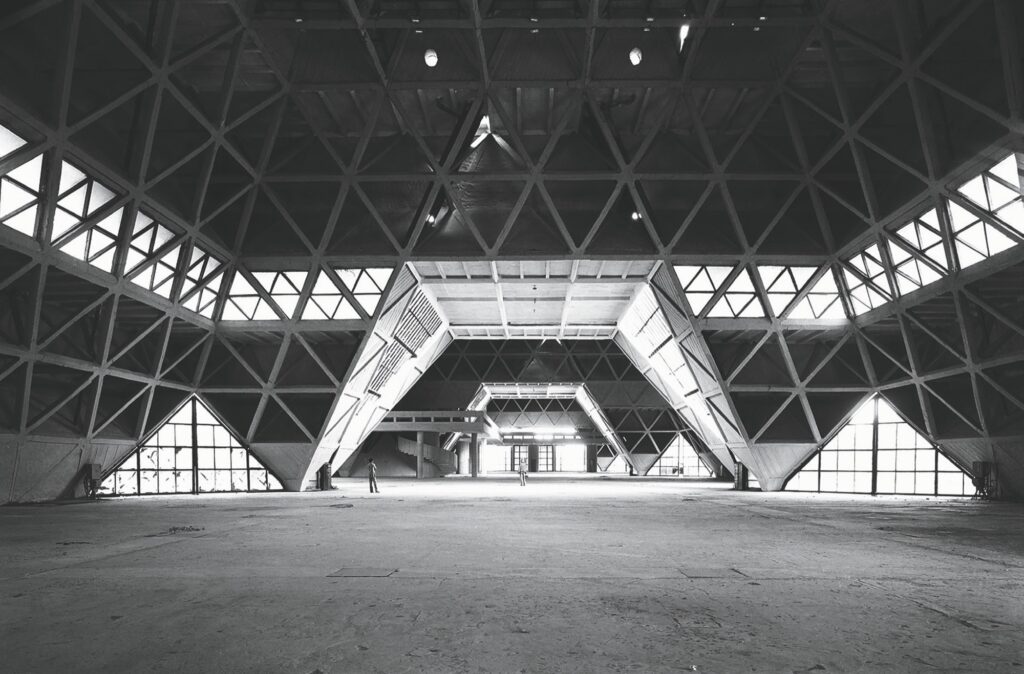
The demolition of the Hall of Nations brought into focus the complexity of what makes a building iconic. It highlighted the intersection between a structure’s physical attributes, cultural significance, historical relevance, and its impact on the community. While the physical structure may no longer exist, the Hall of Nations’ legacy lives on in the hearts and minds of those who admired its architectural brilliance and the ideals it represented for India.

FOR HALL OF NATIONS AND INDUSTRIES CAPTIONS FOR IMAGES AND DRAWINGS
By Vandini Mehta , Rohit Raj Mehndiratta from “The Hall of Nations and Halls of Industries, New Delhi, 1972.”
References:
- “Cannot let history shackle us from upgrading infrastructure”: Architect for Pragati Maidan project. (2023, July 26). The Indian Express. https://m.dailyhunt.in/news/india/english/the+indian+express-epaper-indexp/cannot+let+history+shackle+us+from+upgrading+infrastructure+architect+for+pragati+maidan+project-newsid-n522004760?s=a&uu=0x15f371b30643b474&ss=wsp&sm=Y
- Brott, S. (2012). Modernity’s Opiate, Or, The Crisis of Iconic Architecture. Log, 26, 49–59. http://www.jstor.org/stable/41765759
- Stott, R. (2017). Patrik Schumacher: “The Denunciation of Architectural Icons and Stars is Superficial and Ignorant.” ArchDaily. https://www.archdaily.com/617944/patrik-schumacher-the-denunciation-of-architectural-icons-and-stars-is-superficial-and-ignorant
- Brott, S. (2012). Modernity’s Opiate, Or, The Crisis of Iconic Architecture. Log, 26, 49–59. http://www.jstor.org/stable/41765759
- Scriver, Peter, and Amit Srivastava. “Development and Dissent: The Critical Turn, 1960s-1990s.” In India: Modern Architectures in History. Modern Architectures in History. Reaktion Books, 2016.
- Scriver, Peter, and Amit Srivastava. “5. Development and Dissent: The Critical Turn, 1960s-1990s.” In India: Modern Architectures in History. Modern Architectures in History. Reaktion Books, 2016.
- Matra, A., & Matra, B. A. (2016, March 16). Engineer behind iconic Hall of Nations and Nehru Pavilion campaigns against “disastrous” move to. . . Mail Online. https://www.dailymail.co.uk/indiahome/indianews/article-3495806/Engineer-iconic-Hall-Nations-Nehru-Pavilion-campaigns-against-disastrous-demolish-them.html
- Mehta, Vandini, Rohit Raj Mehndiratta, and Ariel Huber. “Hall of Nations and Halls of Industries, New Delhi, 1972.” In The Structure – Works of Mahendra Raj. 152-179. University of Chicago Press, 2016
- Scriver, Peter, and Amit Srivastava. “Development and Dissent: The Critical Turn, 1960s-1990s.” In India: Modern Architectures in History. Modern Architectures in History. Reaktion Books, 2016.
Also Read
Tearing down an icon
Demolition of the Hall of Nations signals a failure to engage with history and public memory; by Rohit Raj Mehndiratta
Preservation of Indian Architectural Heritage:
Different Perceptions of Indian Heritage
By Rohit Raj Mehndiratta, Vandini Mehta, Cláudia Estrela, PortoAline de Carvalho








One Response
Demolition of the Hall of Nations was an act of wanton destruction. Whereas as its replacement has only managed to project a poor icon of mediocrity.